
- •60. Plan of Suzdal n the 11th and 12th century (compiled by a. Varganov)
- •Historic buildings
- •61. View of the kremlin ensemble (taken before the restoration of the cathedral)
- •62. Cathedral of the Nativity. Detail of the south portal
- •63. Cathedral of the Nativity. Detail of the south front
- •66. Western Golden Gates in the Cathedral of the Nativity. 1230-1233
- •69 Details of the western Golden Gates in the Cathedral of the Nativity 1230-1233
- •72. Church of St. Nicholas from the village of Glotovo. 1766
- •73. Church of St. Nicholas. 1720-1739
- •74. Church of St. Cosmas and St. Daminn.1725
74. Church of St. Cosmas and St. Daminn.1725
As you cross the bridge over the Kamenka it is worth remembering that a rampart with a wooden stockade once ran along the left bank. On the left stands the delightful church of St. Cosmas and St. Damian beautifully situated on a sandy bank at a sharp bend in the river (Ill. 74). This church, restored in 1960 by R. S. Kuznetsov, was erected in 1725 on the site of the second oldest monastery in Suzdal, the Monastery of St. Cosmas and St. Damian. It was built, however, entirely in the spirit of the seventeenth century, a fact which can be seen from its attractive asymmetrical composition. The simple, cube-shaped, single-domed body of the church is adjoined on one corner by a slender bell-tower in the form of an octagon on a square base, similar to the bell-tower of the Church of St. Nicholas in design but very austere and almost completely devoid of decoration. The arches of the bell-tier are capped by small ogee-shaped coverings above which rises a narrow tent-shaped spire with slit windows and a minute dome. Standing next to the plain cube of the church the bell-tower looks particularly tall and light. This charming ensemble was completed by the addition of a chapel with a slender dome, adjoining the south wall of the church. The buildings were originally surrounded by a stone wall with a flight of steps in line with the centre of the bell-tower leading down to the river. The ensemble must have looked like a little town behind its stone walls. It is particularly attractive on a clear day when you can see its gleaming white reflection in the river below.
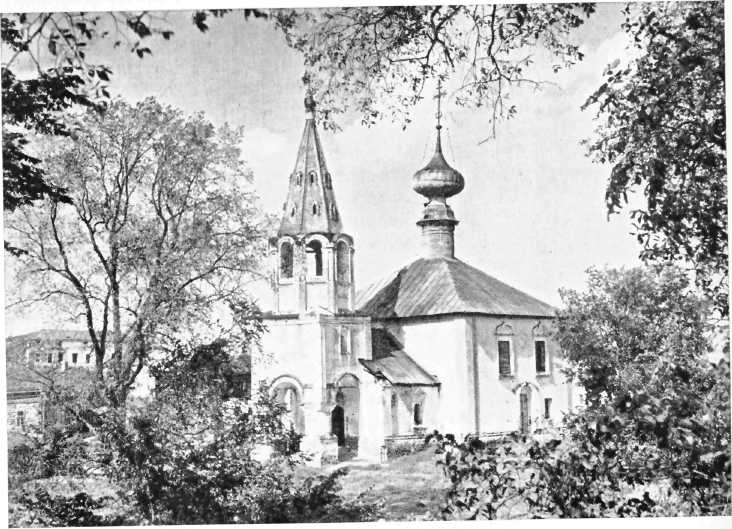
75. Church of John the Baptist .1720

76. The churches of the Entry into Jerusalem and St Paraskeva. 1707-1772 (photograph taken in 1910)
Further along the Vladimir road on the left is the Church of the Sign (1749) standing on the steep bank of the little river Mzhara. Many centuries ago the Monastery of the Presentation was founded here and in the seventeenth century the village of Pinaikha stood not far away. The church's broad, deeply recessed portal with its shallow arch is submerged in shadows by an impressive porch with stocky, faceted pillars. It is possible that the porch was originally surmounted by a bell-tower. The south wall with its large regularly spaced windows is reminiscent of civic architecture, whereas the north wall, which faced the town, was more richly decorated and contained a second portal. Instead of kokoshniks there is a series of paintings on various religious themes between the two cornice bands, and on the west side there are two more large windows. The architects were obviously anxious to make the inside of the small church as light as possible. The upper octagonal section under the dome is decorated with blue and white tiles of the type used on Russian stoves, instead of the polychrome glazed tiles favoured by seventeenth-century builders. The church was restored by Alexei Varganov in 1959. Nearby is the small heated Church of the Deposition of the Robe built in 1777 by the Zubkov merchant family. In spite of its severe, Classical lines it also reveals traces of early Suzdalian architecture. Its two intersecting double-hipped roofs are reminiscent of the refectory church in the Archbishop's Palace.
From the eastern end of the Church of the Sign there is a particularly good view of the old burial mound on the other side of the Mzhara.
Many of Suzdal's old buildings are concentrated around the area which used to be the central square and market place of the posad. We have already described where the wooden churches of this part of the town were located in the seventeenth century, some of them grouped by the gates and others lining the market place. In most cases the existing stone churches stand on tin-site of earlier wooden ones and date back to the eighteenth century, some to the seventeenth. Even with so many buildings of the same type the Suzdal builders managed to avoid repetition, and each church has its own individual character with regard to general composition and decoration.
On the left-hand side as you leave the Vladimir road there is the Church of John the Baptist (Ill. 75) which stands on the site of an old wooden tent-shaped church right on the edge of the moat round the kremlin. The present church was built in 1720 at the same time as the Church of St. Nicholas in the kremlin and yet they are completely different in character. It too consists of a bell-tower to the west, a narthex-type refectory and then the main body of the church, but the total effect is extremely impressive, almost austere. The cube-shaped body of the church with pilaster strips on the corners, which give the effect of the vertical boarding used to cover the ends of logs in wooden buildings, is very reminiscent of the simple, rectangular type of wooden churches of the seventeenth century. The walls have no cornices and end with the horizontal line of the hipped roof. The window surrounds are also restrained. The building has a definite touch of the Novgorod and Pskov schools, an impression which is heightened by the austere bell-tower. The base of the tower resting on two strong pillars forms the church porch, similar to the one which we saw in the bell-tower of St. Nicholas at the Galleys in Vladimir. Like the church itself, the corners of the upper section of the bell-tower's square base are decorated with pilaster strips. Its simple form is emphasised by dark small windows. The square base supports a comparatively short octagon with the bell-tier and a number of slender half columns which contrast with the overall severeness of line. Т-he tent-shaped steeple has straight sides sloping at a gradient of 1:2 with tiny slit windows. The architect clearly preferred laconic architectural lines to rich decoration, although the magnificent portal of curved brick was evidently the work of a craftsman with a keen appreciation of ornament. Standing under the vaults of the porch in a fine interplay of light and shadow the portal enhances the dignified simplicity of the building as a whole.
In the southwest corner of the market place we see the Church of the Entry into Jerusalem (1707) on the right and the Church of St. Paraskeva (1772) on the left. The latter is also known as the Church of St. Nicholas. These two churches once formed a very attractive ensemble (Ill. 76). They were originally surrounded by a low brick wall with unusual stone gates. The gates were crowned by a vaulted stone roof in the form of a cruciform bochka, or cask, a design borrowed from wooden architecture, with the result that each of the walls terminated in an ogee-shaped zakomara. Another important feature of the ensemble was the slender bell-tower with a concave tent-shaped spire standing between the two churches. It was one of the oldest specimens of this type of Suzdalian bell-tower and a real architectural masterpiece with its simple lines and smooth surfaces, relieved only by the large decorative niches in the bell-tier and the purely ornamental window surrounds on the tent-shaped spire (the architect did not provide it with any small windows). The most interesting of the two surviving churches is the older one, the Church of the Entry into Jerusalem, which retains something of seventeenth-century architecture and is similar in type to the Church of John the Baptist. The corners of the cube-shaped body of the church are also covered with pilaster strips, but its walls are more richly decorated. The windows have fine surrounds with particularly ornate tops. There is a rich frieze of small kokoshniks resting on consoles and the motif of blind arcading is repeated on the dome drum. The church originally had five domes.
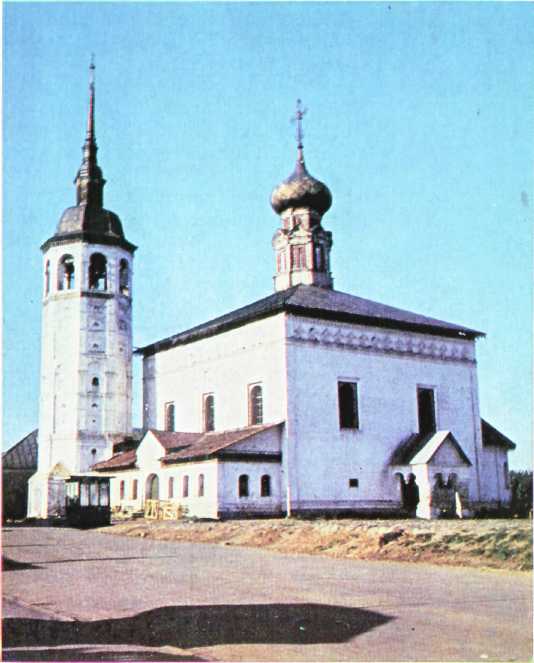
77. Church of the Emperor Constantine.1707
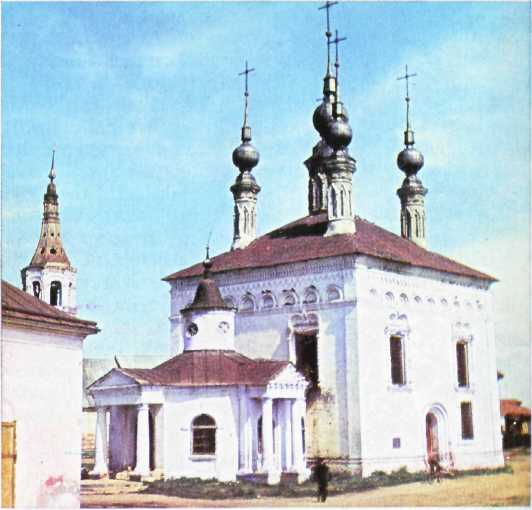
Church of the Resurrection 1720
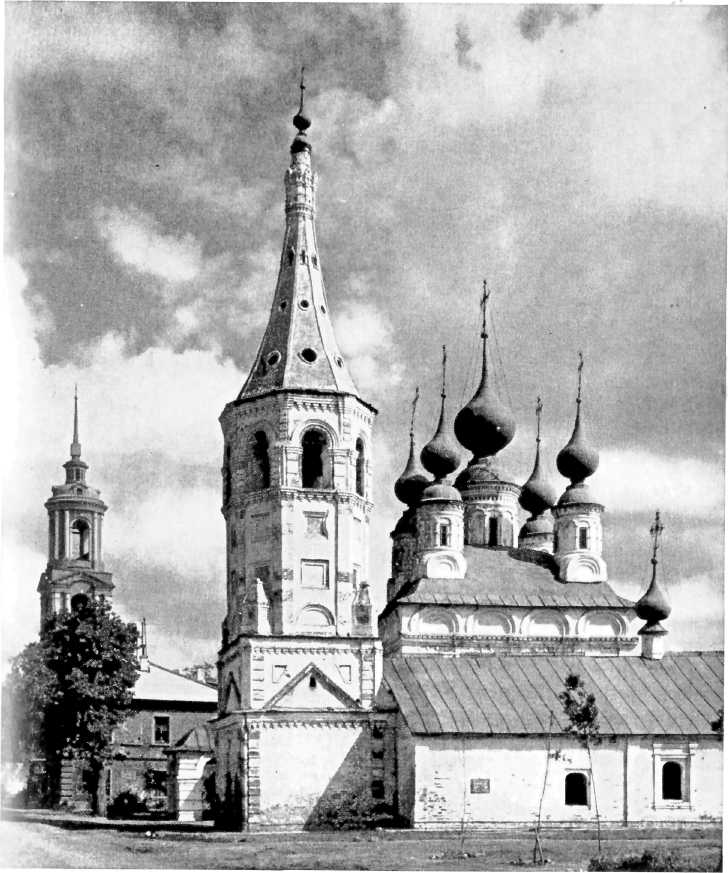
79. Churches of St Lazarus and St. Antipius. 1667, 1745
The west side of the square is taken up by the long building of the Costiny Dvor containing arcades of small shops erected between 1806 and 1811 and designed by A. Vershinsky, the head architect of the Vladimir gubernia. As in the case of the Vladimir civic buildings erected during this period the authorities showed little concern for preserving the picturesque panorama of this section of the town which stood on the high left bank of the Kamenka and was visible from the kremlin and the low-lying meadows across the river. The dirty storage yard of the building faced in this direction. This is how I. M. Dolgoruky described the new addition to the town. "The Gostiny Dvor with its collonade is now completed. For every five empty stalls inside it there is a sixth one selling rubbish. Ostentation is a general human weakness. The citizens of Suzdal decided that they wanted a long, large Gostiny Dvor taking up a whole block and now they parade up and down admiring it." The building conjures up the spirit of nineteenth-century provincial life frequently described in Russian literature of the period. It was the centre of the town and people came here not so much to shop as to stroll along the arcades, gossiping, surveying the passers-by and showing off their elegant clothes. Rich citizens paraded their sons and daughters and looked over possible matches for them, then set off home to brood over and weigh up everything they had seen, with the bell of the cathedral clock tolling away each minute of their empty, monotonous lives.
In front of the Gostiny Dvor there is a group of churches marking the right-hand, southern edge of a cluster of seventeenth-century wooden churches which stood in a line parallel with the rows of trading stalls and were burnt down in 1719. The present Church of the Resurrection stands on the site of a wooden, tent-shaped church of the same name. Its stone bell-tower was built in the same style as the old church and, like the latter.
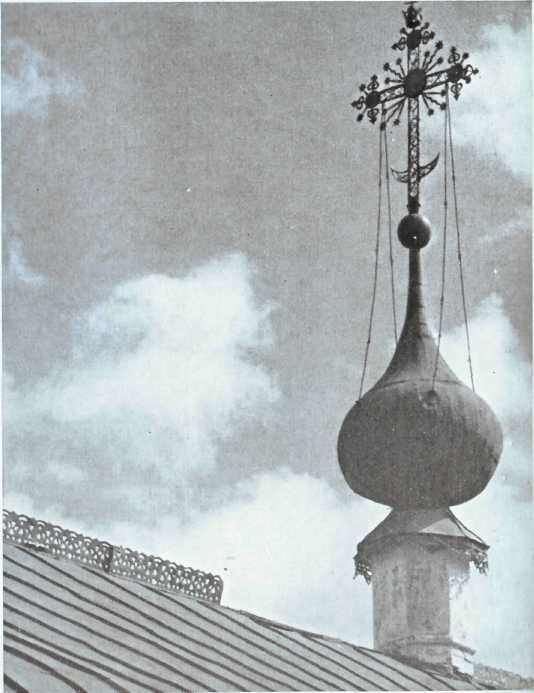
80. Church of St. Antipius. Dome and metalwork crest. 1745
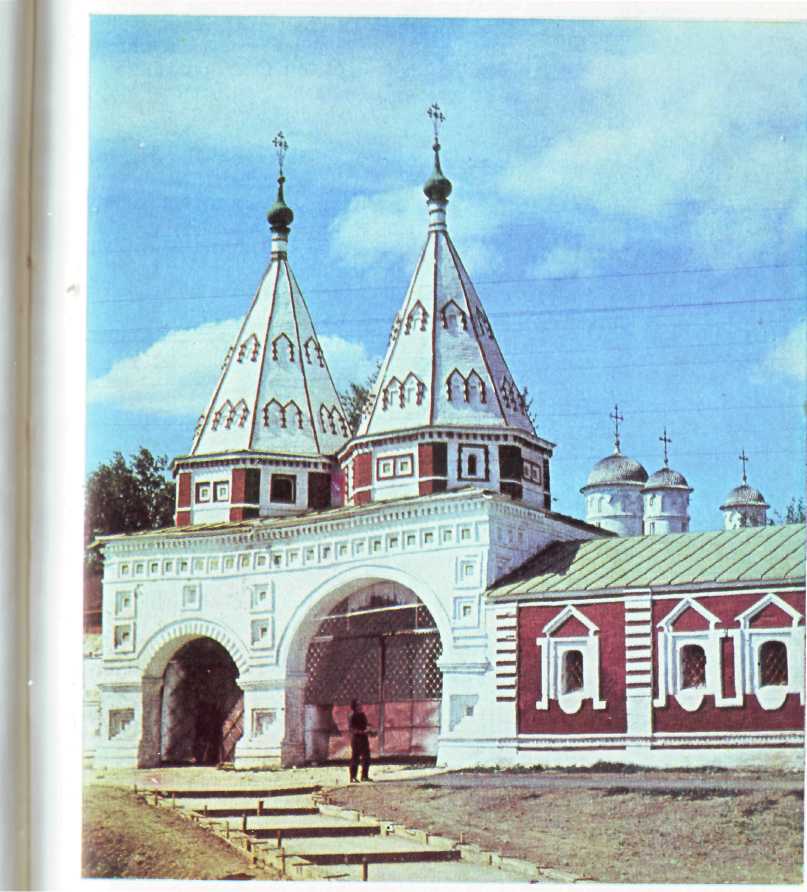
81. Holy Gates of the Convent of the Deposition of the Robe. 1688
